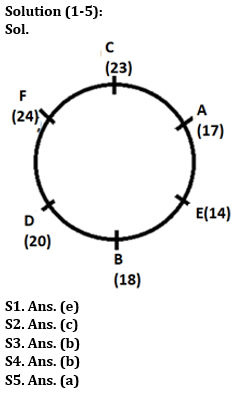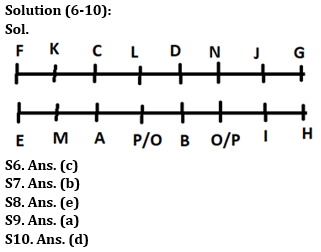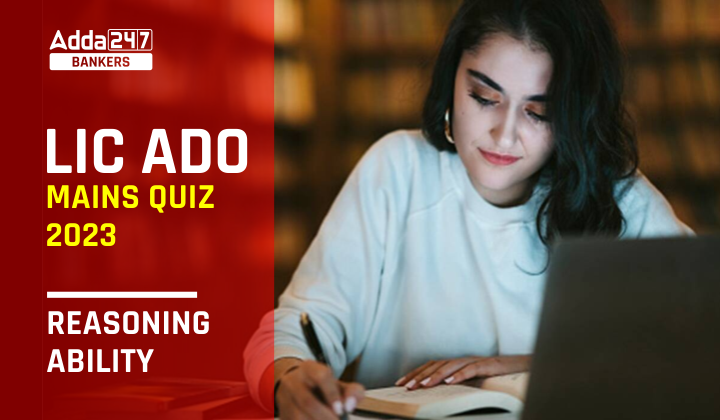Directions (1-5): Answer the questions based on the information given below:
Six persons A, B, C, D, E and F sit around a circular table (not necessarily in the same order) facing towards the centre. Each of them has different number of years’ experience working in bank i.e., 14, 17, 18, 20, 23 and 24 but not necessarily in the same order. The distance between each adjacent person is equal.
C sits immediate left of F. A sits second to the right of B. A has 1 year less experience than B. C does not have 17 years of experience. F neither has 20 nor 23 years of experience. D faces the person who is second least experienced among all and the sum of their experience is not 40. The person who sits second to the right of D, is the least experienced among all. F has more than 17 years of experience.
Q1. E has how many years of experience?
(a) 23
(b) 24
(c) 18
(d) 20
(e) None of these
Q2. What is the sum of the years’ experience of D and C?
(a) 44
(b) 40
(c) 43
(d) 32
(e) None of these
Q3. What is the position of the person who is the least experienced with respect to the person who is the most experienced among all?
(a) 2nd to the right
(b) 3rd to the left
(c) 4th to the right
(d) 2nd to the left
(e) Immediate left
Q4. What is the absolute difference in the years of experience of the neighbours of B?
(a) 1
(b) 6
(c) 3
(d) 7
(e) None of these
Q5. Who among the following sit between F and B if counted from the right of F?
(a) The one who has 20 years’ experience
(b) The one who has 23 years’ experience
(c) C
(d) The one who has 17 years’ experience
(e) None of these
Directions (6-10): Answer the questions based on the information given below.
16 persons A, B, C, D, E, F, G, H, I, J, K, L, M, N, O and P are seating in two parallel rows such that 8 persons are sitting in 1st row while the remaining are sitting in the 2nd row. Every person from the 2nd row is sitting exactly behind each of the persons from 1st row. All the 16 persons are facing towards the north. The distance between each adjacent persons in each row is same.
A is sitting exactly behind the person, who is second to the left of D. D is sitting third to the left of G. K is sitting opposite to M in 1st row. C is sitting at a gap of one person from D. F is sitting second to the left of C. F, E and H are sitting at the extreme ends. B is sitting behind D. Neither B nor D is sitting adjacent to J. K is sitting second to the left L. O and J are not sitting in the same row. I is sitting adjacent to H. P and D are not sitting in the same row. At most two people sit to the left of M.
Q6. Who among the following is sitting exactly behind J?
(a) O
(b) Either O or P
(c) I
(d) Either H or O
(e) None of these
Q7. If P is sitting exactly behind L, then how many persons are sitting between K and the one who is sitting opposite to O?
(a) Two
(b) Three
(c) None
(d) Four
(e) Five
Q8. What is the position of C with respect to J?
(a) 3rd to the right
(b) 2nd to the left
(c) Immediate left
(d) Immediate right
(e) None of these
Q9. How many persons are sitting to the right of M?
(a) Six
(b) Three
(c) Five
(d) Four
(e) None of these
Q10. Four from the following are similar in a certain way and forms a group. Find out the one who does not belong to that group?
(a) C – A
(b) K – M
(c) J – I
(d) L – B
(e) F -E
Directions (11-15): In each of the questions given below, a group of letters is given followed by some combinations of number/symbol. You have to find out which of given combination correctly represents the group of letters based on the numbers/symbols codes and the conditions given below. If none of the given combinations represents the group of letters correctly, give (e) i.e. ‘None of these’ as the answer.
![]()
Condition for coding the group letters:
(i) If the first letter is a vowel and the last letter is consonant, then the codes for the first and the last letter are to be interchanged.
(ii) If the first as well as the last letter is a vowel, then both are to be coded by the code for the last letter.
(iii) If the first as well as the last letter is consonant, then both are to be coded by the code for the first letter.
(iv) If the first letter is consonant and the last letter is a vowel, then the codes for the first and the last letter are to be coded as μ.
(v) If the first as well as the last element is a number, then both are to be coded by the code for the last number.
Q11. Find the code for ‘U1B2A’?
(a) ^π *∞$
(b) $π *∞$
(c) ^π *∞^
(d) ^π *∞#
(e) None of the above
Q12. Find the code for ‘987654’?
(a) +€%Ω@ π
(b) +€%Ω@+
(c) >€%Ω@>
(d) +€%Ω@!
(e) None of the above
Q13. Find the code for ‘PWCYX’?
(a) ®©¥/®
(b) ®©¥/?
(c) ®©/¥?
(d) /#©¥®
(e) None of the above
Q14. Find the code for ‘A2T3SP’
(a) ®∞!&@$
(b) ®∞&!=$
(c) $∞&!@®
(d) $∞!&@®
(e) None of the above
Q15. Find the code for ‘X864U’?
(a) μ€Ω>μ
(b) μΩ€πμ
(c) ?Ω€πμ
(d) μ€πΩμ
(e) None of the above
Solutions


S11. Ans. (b)
Sol. Condition (ii) is applied.
S12. Ans. (c)
Sol. Condition (v) is applied.
S13. Ans. (a)
Sol. Condition (iii) is applied.
S14. Ans. (b)
Sol. Condition (i) is applied.
S15. Ans. (a)
Sol. Condition (iv) is applied





 GA Capsule for SBI Clerk Mains 2025, Dow...
GA Capsule for SBI Clerk Mains 2025, Dow...
 The Hindu Review October 2022: Download ...
The Hindu Review October 2022: Download ...
 ECGC PO Scorecard 2025 Out, Check Marks
ECGC PO Scorecard 2025 Out, Check Marks




